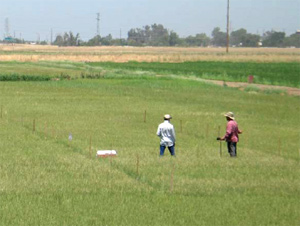Summary
Project title: Evaluation of alternative nitrogen sources for California rice systems
Investigator: Bruce Linquist, Dept. of Plant Sciences, University of California, Davis, CA
Project location: Sacramento Valley, California
Recently, PL availability as a fertilizer resource has become limited due to changes in poultry house management and new state regulations on unprocessed organic wastes from poultry farms. This has forced organic rice growers to search for alternative fertilizers. Other disadvantages of PL as a fertilizer made this search desirable: PL nutrient composition among suppliers is variable, the product is difficult to apply in the field due to both clumps and dustiness, and the timing of nutrient release is inconsistent.
Other sources of organic N fertilizer have been available on the market but the efficacy of these fertilizers for rice production, where the rice is grown under flooded, anaerobic conditions, were to date untested. The options for top-dress fertilizers are limited as the products are flown on to the fields (because rice fields are usually flooded) and the fertilizers must not float on the water surface.
Therefore, the objectives of the present study were to (1) to determine the effectiveness of organic fertilizer N mineralization in meeting rice crop N demand, as reflected by plant N uptake, NRE, and improved grain yield; (2) to determine N mineralization rates of organic fertilizers, i.e., poultry litter, blood and bone meal, feather meal, and poultry litter plus feather meal under anaerobic conditions; and (3) to compare the returns on investment in the pelletized organic materials with those of poultry litter.
Field trials were conducted at Scheidel Ranch in Nicolaus, California, in two adjacent fields in 2009. The two fields were managed differently by the grower. One field was continuously flooded over the course of the growing season (henceforth referred to as CF field). The other field was drained at 25 days after sowing (DAS) and remained dry for one month as a weed control measure, a common practice in organic rice production (henceforth referred to as drained field). The drained field was then re-flooded at 55 DAS, however the drain period slowed the rice growth and resulted in a delayed harvest. The difference in field management between the CF and the drained field influenced project results.
Trials were planted in a randomized complete block design with an N-responsive rice variety (S-102) and fertilized at a rate of 134 kg ha-1 (120 lb ac-1) with four sources of N fertilizer as treatments (N rates were based on manufacturer’s stated N-concentration as listed below):- Poultry litter (PL) 3% N;
- Pelleted PL and feather meal 6% N (6-3-2);
- Pelleted feather meal 12% N (12-0-0);
- Pelleted bone and blood meal 13% N (13-0-0).
- An unfertilized control (no N) was also used.
Organic phosphorus and potassium were applied to all plots to ensure that these nutrients were not limiting. Aboveground biomass, grain yield, plant N-uptake, and soil ammonium-N (NH4+-N) were measured at different stages of crop growth. An anaerobic laboratory incubation with the aforementioned fertilizers was conducted to quantify mineralization rates of the organic fertilizers.


